Delicious & Healthy Gluten-Free Buckwheat Pancakes: Your Ultimate Weekend Breakfast Guide
Discover the delightful world of **buckwheat pancakes** – golden, fluffy, and incredibly versatile. These aren’t your average pancakes; they offer a unique nutty, earthy flavor profile that elevates any breakfast or brunch. Despite its name, buckwheat is a naturally gluten-free pseudocereal, making this recipe a fantastic choice for everyone, including those with gluten sensitivities. Whether you’re planning a leisurely weekend breakfast, a special holiday feast, or simply craving a hearty and wholesome start to your day, these pancakes are a perfect fit. They are remarkably easy to prepare and can even be made in advance, allowing you to enjoy a delicious meal without the morning rush. Prepare to fall in love with these satisfying pancakes, piled high with your favorite toppings.

While buckwheat might seem like a trending ingredient in today’s health-conscious culinary scene, its use spans centuries across diverse cultures. From the delicate Japanese soba noodles and the savory French galettes (buckwheat crepes) to the rich Russian blini, buckwheat flour has been a staple, cherished for its distinct flavor and nutritional value. Now, you can effortlessly bring this ancient superfood into your home kitchen and create truly fantastic buckwheat pancakes from scratch. This comprehensive guide will walk you through everything you need to know to make perfect, fluffy buckwheat pancakes that will impress your family and friends.
Buckwheat is not a true grain but rather a “pseudocereal,” similar to quinoa and amaranth. It’s the fruit of a plant related to rhubarb, and crucially, it is naturally gluten-free. This makes it an excellent alternative for those avoiding wheat. Beyond being gluten-free, buckwheat is a nutritional powerhouse, packed with high-quality protein, dietary fiber, and a variety of essential minerals and antioxidants. Its robust, earthy, and nutty taste, coupled with its rich brown color, adds depth and character to these pancakes. Get ready to indulge in this delightful buckwheat pancake recipe, enhanced by a generous array of your most beloved toppings.
Why You’ll Absolutely Love This Buckwheat Pancake Recipe
This particular buckwheat pancake recipe stands out for several compelling reasons, promising a delightful culinary experience that keeps people coming back for more. It’s been meticulously tested and refined to ensure consistent, delicious results every time.
- Unique and Earthy Flavor: Unlike traditional pancakes, buckwheat pancakes offer a distinct earthy and nutty flavor that is both satisfying and intriguing. It’s a gourmet twist on a classic breakfast staple that’s sure to impress.
- Versatile Topping Options: These pancakes serve as the perfect canvas for a wide array of toppings. Whether you prefer the classic sweetness of maple syrup or honey, the vibrant tang of fruit syrups and fresh berries, or even a savory accompaniment, they beautifully complement buckwheat’s rich profile.
- Convenient & Make-Ahead Friendly: Designed for modern lifestyles, this recipe allows you to prepare a batch of pancakes ahead of time. Simply warm them up when you’re ready to serve, saving precious time on busy mornings or during holiday gatherings.
- Customizable Flour Combinations: Enjoy the flexibility to tailor the recipe to your preferences. Make them with 100% buckwheat flour for a bolder flavor and denser texture, or combine buckwheat flour with gluten-free flour blends or even regular all-purpose flour for a lighter, more familiar consistency.
- Dietary Inclusivity: This recipe effortlessly accommodates various dietary needs. Easily prepare completely gluten-free pancakes or opt for regular buckwheat pancakes by choosing your preferred flour blend. The base recipe is incredibly adaptable, ensuring everyone at the table can enjoy.
- Proven Success: The primary reason this is hailed as “the best recipe” is its rigorous testing. It has been made repeatedly, ensuring reliability and deliciousness with every single batch.
If you’re a fan of morning delights and want to explore more gluten-free options, be sure to try these golden gluten-free waffles. They are equally delicious and perfect for a special breakfast or brunch occasion.
Essential Ingredients for Perfect Buckwheat Pancakes
Crafting the perfect batch of buckwheat pancakes starts with selecting high-quality ingredients. Each component plays a vital role in achieving that ideal texture and flavor. Here’s a detailed look at what you’ll need and why:
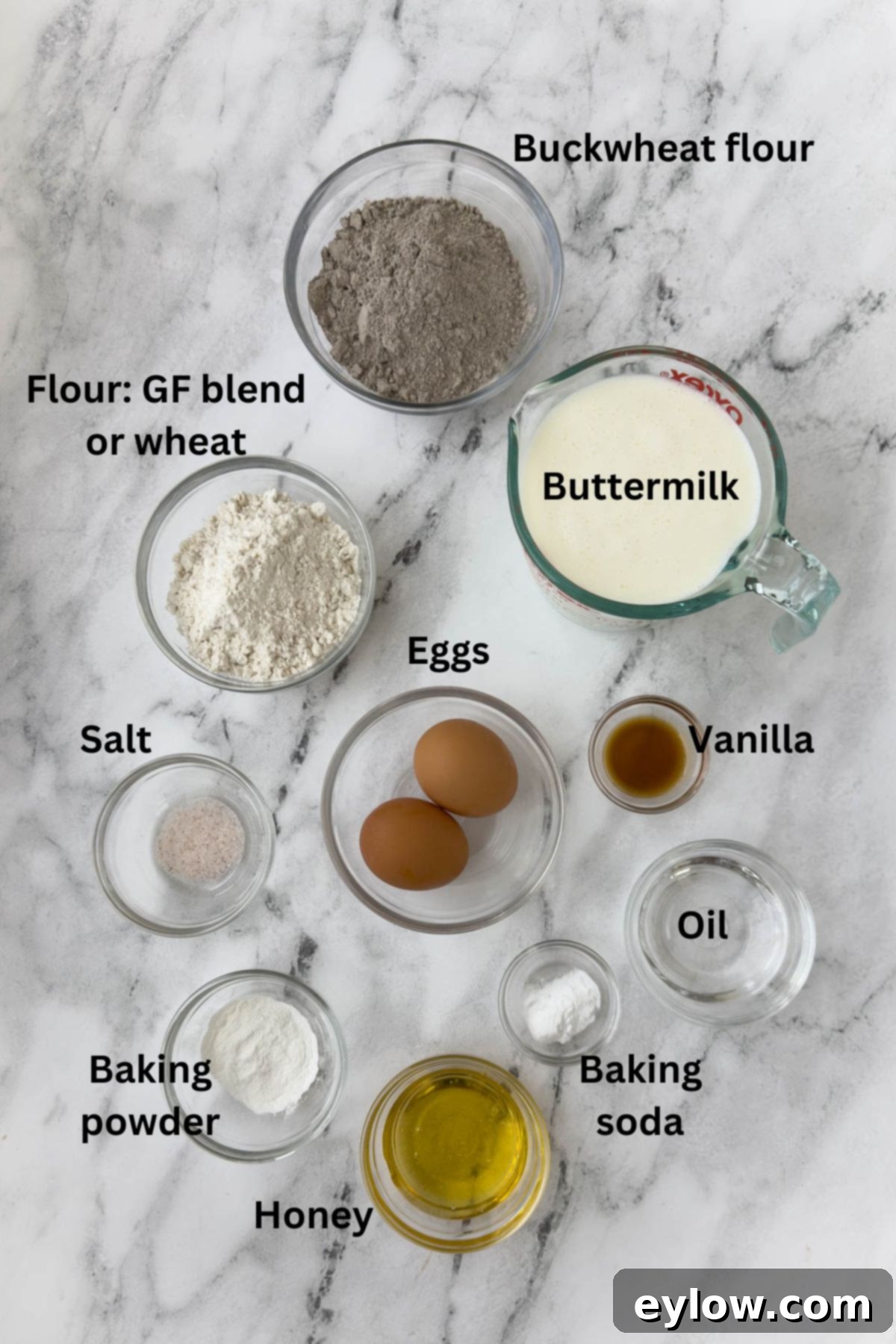
- Buckwheat Flour: This is the star of our recipe! Buckwheat flour is a fantastic whole grain flour, naturally rich in protein and dietary fiber, and completely gluten-free. It imparts a distinct nutty, earthy flavor and a beautiful darker hue to the pancakes. You can generally find it in most major grocery stores, often in the baking aisle or the gluten-free section. Be aware that there are different kinds of buckwheat flour available, which we’ll discuss in more detail below in our Chef’s Tip.
- All-Purpose or Gluten-Free Flour: To balance the robust flavor and texture of buckwheat flour, we blend it with another type of flour. You have several options:
- Gluten-Free Flour Blend: If you’re aiming for entirely gluten-free pancakes, choose a reliable gluten-free blend that ideally contains xanthan gum for structure.
- All-Purpose Flour: For those not concerned with gluten, standard all-purpose flour works wonderfully, creating a lighter, more tender pancake.
- Whole Wheat Flour: For an even heartier and more nutritious option, whole wheat flour can also be used, adding another layer of wholesome goodness.
- Leavening Agents: Both baking powder and baking soda are essential for achieving light, fluffy pancakes. Baking powder provides the initial lift, while baking soda reacts with the acidity in the buttermilk (or its substitute) to create additional bubbles, resulting in that desirable airy texture. Always check the expiration dates on your packages to ensure they are fresh and active for maximum leavening power.
- Eggs: Eggs are crucial binders in this recipe, providing structure, stability, and moisture. They help hold the pancakes together and contribute to their rich texture. Use large, fresh eggs and ensure they are clean and free from cracks before incorporating them into the batter.
- Oil: The choice of oil impacts both the texture and health profile of your pancakes. Opt for a healthy, neutral-flavored oil such as melted coconut oil (ensure it’s completely melted and slightly cooled), MCT oil, or a high-quality healthy neutral oil like those from Zero Acre Farms. Avoid vegetable oils high in unhealthy fats.
- Honey: A touch of sweetness enhances the natural flavors of buckwheat. You can use regular honey for its classic taste or, for a reduced-sugar option, monk fruit honey (which is often my preferred choice). Granulated sugar can also be used if honey is not available.
- Vanilla: Vanilla extract adds a warm, aromatic depth that complements the earthy notes of buckwheat. While good quality vanilla extract works perfectly, if you’re a true vanilla enthusiast, consider experimenting with vanilla paste for an even richer, more intense vanilla presence.
- Buttermilk: This ingredient is key to the pancakes’ texture. Because buttermilk is fermented and acidic, it reacts with the baking soda to activate its leavening properties, producing lighter and fluffier pancakes. For substitution options if you don’t have buttermilk on hand, please refer to the “Substitutions and Variations” section below.
For precise measurements, additional ingredients, and detailed nutritional information, please refer to the comprehensive recipe card provided further down this page.
Chef’s Tips on Buckwheat Flour: The type of buckwheat flour you choose can significantly influence the final outcome of your pancakes in terms of color, flavor, and texture. For developing this recipe, I primarily used Bob’s Red Mill Buckwheat Flour. This is what’s known as dark buckwheat flour, characterized by its darker color and richer, more pronounced earthy flavor. It’s ground with the outer hulls of the buckwheat groats, which contributes to its robust profile and makes it excellent for hearty baked goods like quick breads. You might also encounter “light” buckwheat flour, which is more finely ground and has a lighter color because the hulls have been removed. Some bakers prefer this for a milder flavor and lighter-colored finished product. If you’re looking for a lighter texture or color in your pancakes, you can experiment with using a combination of dark buckwheat flour and part regular all-purpose or gluten-free flour. Don’t be alarmed by its appearance when you open the bag – dark buckwheat flour can sometimes look a bit like dirt, but rest assured, it’s a wonderfully wholesome and flavorful ingredient!
Creative Substitutions and Delicious Variations
One of the best aspects of this buckwheat pancake recipe is its adaptability. Feel free to experiment with these substitutions and variations to suit your dietary needs or simply to try something new!
- For an Intense Buckwheat Flavor: If you’re a true buckwheat aficionado, you can use all buckwheat flour. Be aware that this will result in a denser pancake with an even darker color and a more pronounced earthy taste. Adjust liquid slightly if needed.
- Boost Your Protein Intake: To make these pancakes even more filling and nutritious, consider adding a little unflavored protein powder to the dry ingredients. Start with 1-2 tablespoons and mix well. You might need to add a splash more buttermilk or milk to achieve the ideal batter consistency, as protein powder can absorb liquid.
- Buttermilk Alternatives: Don’t have buttermilk on hand? No problem! You can easily create a substitute:
- DIY Buttermilk: For 2 ½ cups of buttermilk, substitute with 2 ½ cups of whole milk (or any milk, though whole milk yields the best texture) combined with 2 ½ tablespoons of white vinegar or apple cider vinegar. Let it sit for 5-10 minutes until it slightly curdles and thickens.
- Low on Buttermilk? If you find yourself with only a partial amount, like 2 cups of buttermilk, simply make up the difference with regular low-fat or whole milk. In my experience, even adding ½ cup of low-fat milk worked perfectly in the last batch. The crucial part is having at least some buttermilk, as its acidity is vital for activating the baking soda and ensuring proper leavening.
- Achieving Extra Fluffy Pancakes: For an old-fashioned trick to exceptionally fluffy pancakes, separate the egg whites from the yolks. Whip the egg whites until they form stiff peaks (you can even use an extra egg white for more lift). Gently fold the whipped egg whites into the prepared batter just before cooking. While this adds an extra step, the resulting airier texture is a delightful treat for some! For me, the standard recipe provides enough fluffiness without the extra effort.
- Gluten-Free Flour Blends: If you need to ensure these are 100% gluten-free, they will likely work well with a commercial all-purpose gluten-free flour blend that already includes xanthan gum. Xanthan gum is important for providing elasticity and structure that gluten typically provides.
For more convenient breakfast options, explore these satisfying high-protein overnight oats with chia seeds, perfect for a grab-and-go meal. And if you’re looking to expand your pancake repertoire, you simply must try these delightful blueberry lemon pancakes, offering a burst of fresh flavor.
How to Make Perfectly Fluffy Buckwheat Pancakes: A Step-by-Step Guide
Making delicious buckwheat pancakes is a straightforward process that yields incredibly satisfying results. The key is in the preparation and proper cooking technique. You’ll need either a reliable non-stick skillet or griddle, or a well-seasoned cast iron skillet to achieve that desirable golden-brown exterior and tender interior.

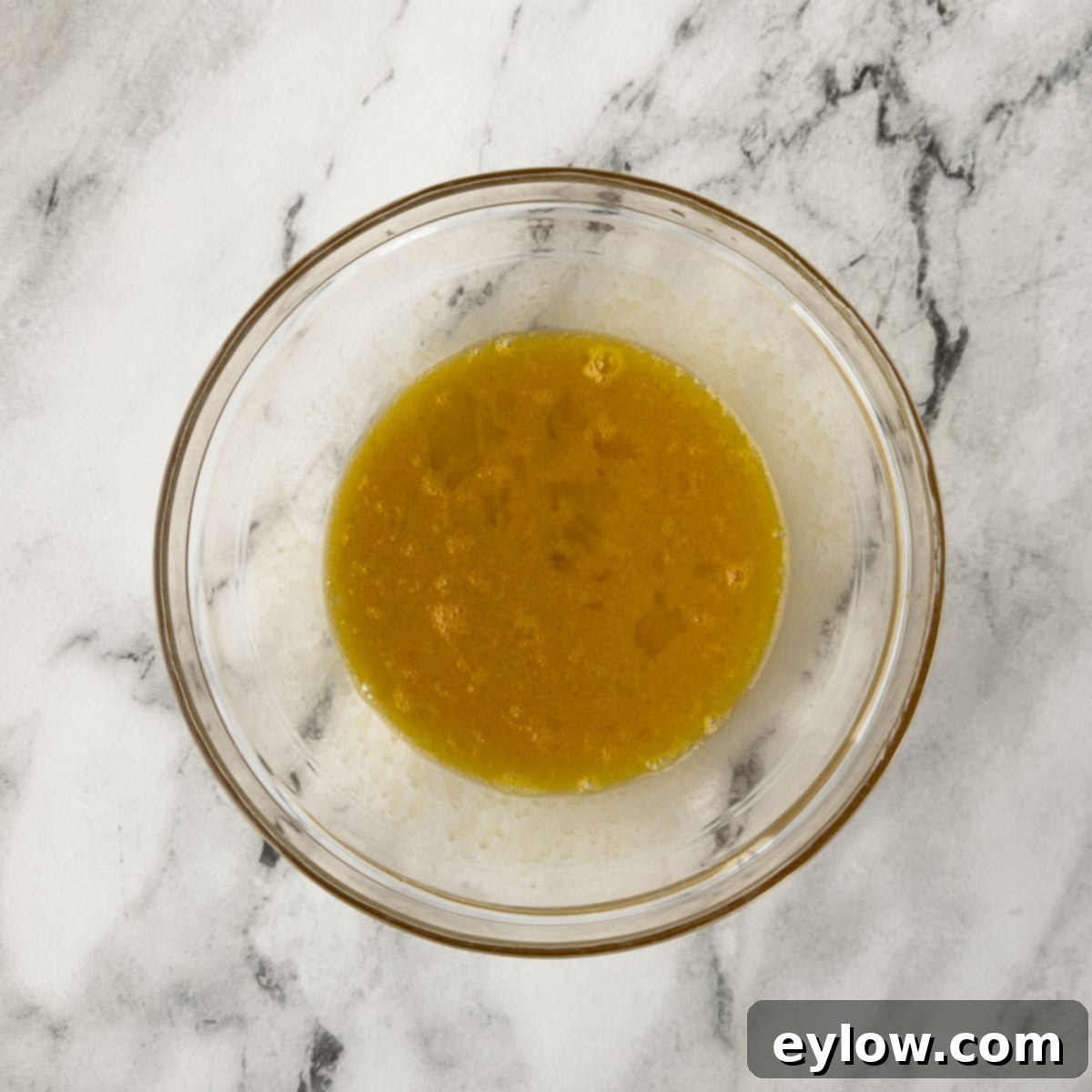

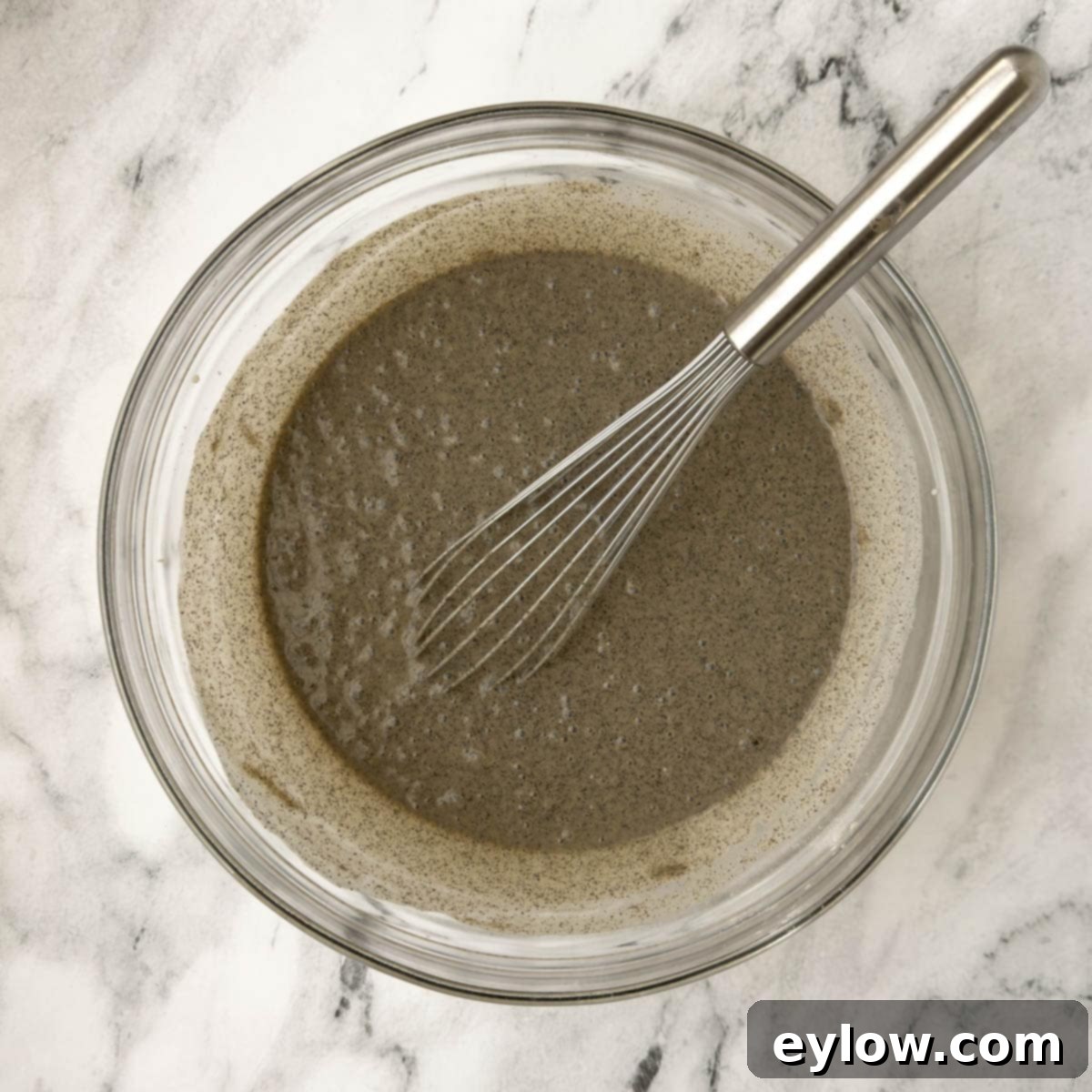
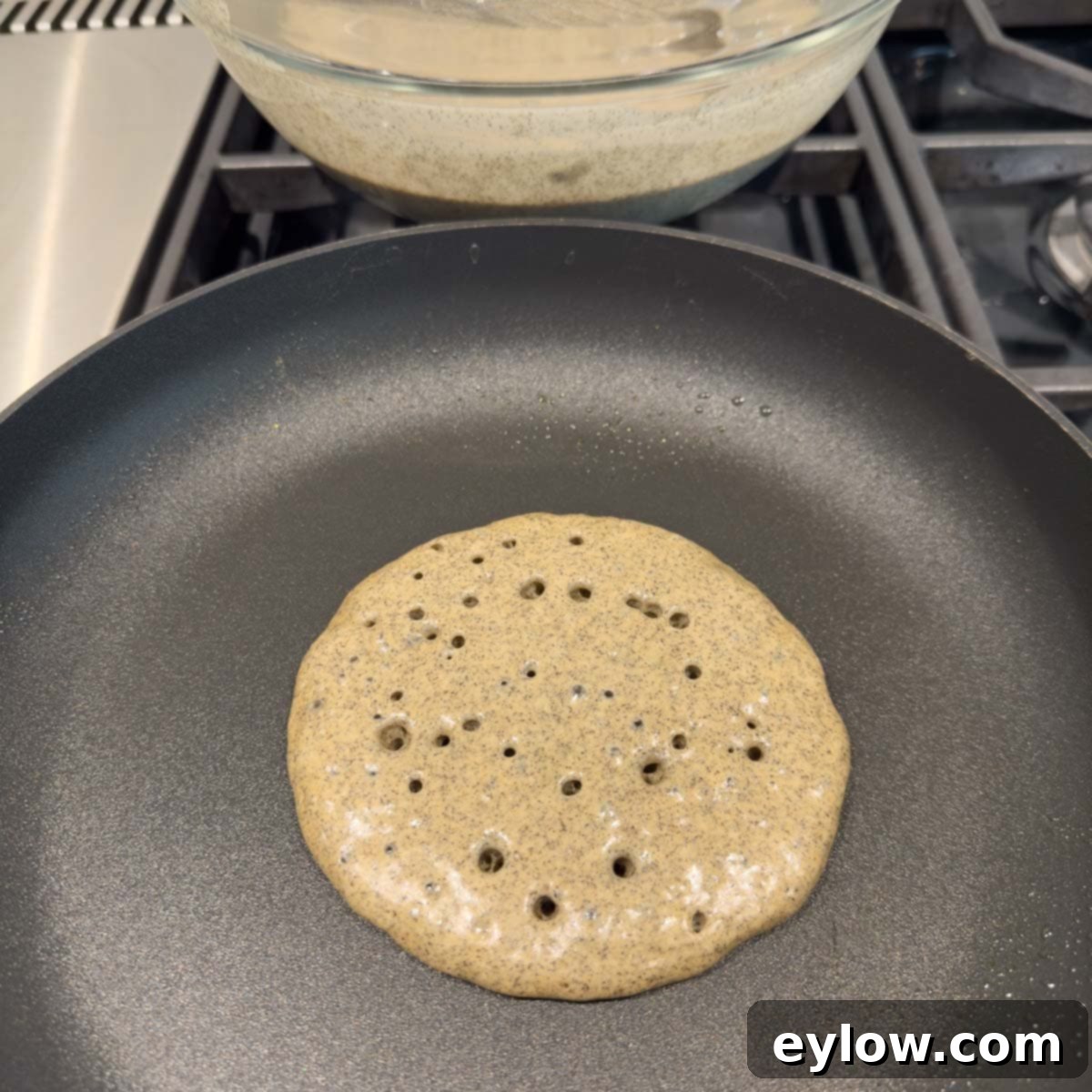
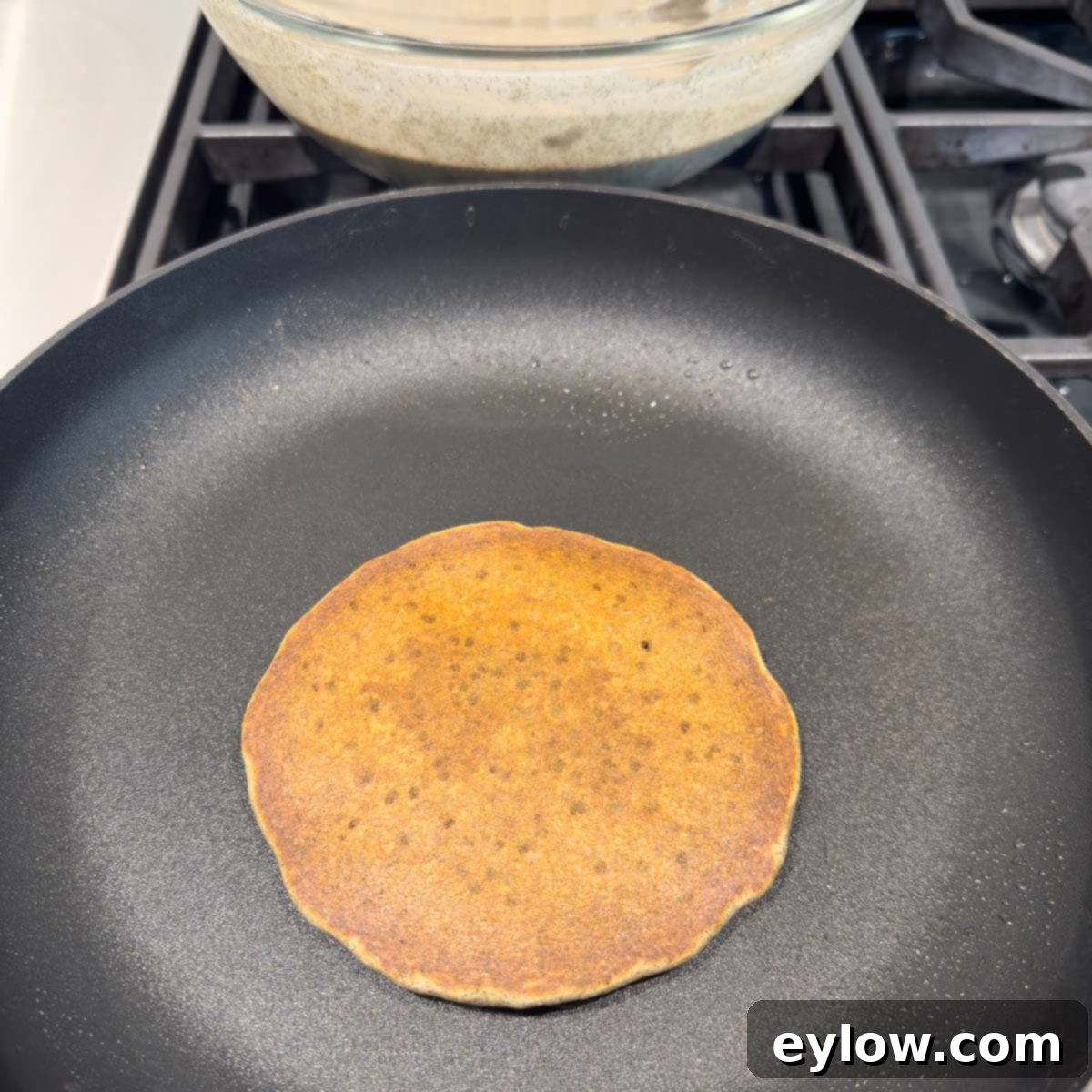
Detailed Instructions for Best Results:
- Prepare Dry Ingredients: In a large mixing bowl, whisk together the buckwheat flour, your chosen second flour (gluten-free blend or all-purpose/whole wheat), baking powder, baking soda, and sea salt. Ensure there are no lumps and the leavening agents are well distributed.
- Prepare Wet Ingredients (Part 1): In a separate medium bowl or a 4-cup liquid measuring cup, whisk the eggs vigorously until they are smooth and slightly frothy. Then, add your chosen oil, honey (or monk fruit honey/sugar), and vanilla extract. Whisk thoroughly until the mixture is well combined and smooth.
- Complete Wet Ingredients: Gradually whisk in the buttermilk to the egg and oil mixture. Continue whisking until everything is uniformly smooth. This completes your wet batter component.
- Combine Wet and Dry: Pour the wet ingredient mixture into the large bowl containing the dry ingredients. Using a whisk or spatula, gently fold and mix until the batter is just combined. It’s perfectly normal, and even desirable, for a few small lumps to remain. **Do not overmix** – overmixing develops gluten and can lead to tough pancakes.
- Heat and Cook: Heat your non-stick pan, griddle, or well-seasoned cast iron skillet over medium heat. To test if it’s hot enough, drop a tiny bit of water; it should sizzle and evaporate quickly. Lightly brush or wipe the cooking surface with a small amount of extra oil (using a paper towel works well).
- Portioning Pancakes: Using a ¼ cup measure for each pancake, gently pour the batter onto the hot pan. Cook for approximately 1 ¼ to 1 ½ minutes on the first side. You’ll know it’s time to flip when you see small bubbles forming and popping on the surface of the pancake, and the edges look set.
- Flip and Finish: Carefully flip each pancake with a thin spatula. Cook for another 1 to 1 ½ minutes on the second side, or until it reaches a beautiful golden brown color. The goal is a golden hue, not a dark brown, so adjust your heat slightly downwards if they are browning too quickly.
- Serving and Keeping Warm: As pancakes finish cooking, you can serve them immediately. If cooking for a crowd, transfer cooked pancakes to a baking tray lined with parchment paper and keep them warm in a low oven (around 200°F or 95°C) or a warming drawer. This ensures everyone gets to enjoy warm, fresh pancakes.
- Final Touch: To serve, drizzle with your favorite warm toppings, such as melted butter, coconut oil, or warm maple syrup. An easy strawberry sauce or fresh fruit also makes a fantastic addition.
Enjoy the process and savor the delicious results of your homemade buckwheat pancakes!
Elevate Your Buckwheat Pancakes: Delicious Serving Suggestions
Buckwheat pancakes are incredibly versatile, serving as a perfect canvas for both sweet and savory toppings. Here are some delicious ideas to enhance your pancake experience:
- Classic Sweetness: A generous drizzle of classic maple syrup is always a winner. For a sugar-conscious option, try monk fruit maple syrup (sugar-free).
- Natural Sweeteners: A swirl of golden honey or a spoonful of pure agave nectar can add delightful natural sweetness.
- Rich & Indulgent: A dollop of melted butter or a simple pat of butter that slowly melts into the warm pancakes is pure bliss.
- Fruity Delights:
- Your favorite fruit jam, marmalade, or fruit preserves.
- A vibrant fruit syrup, like this homemade fresh strawberry coulis, or a mixed berry compote.
- And of course, don’t forget an abundance of fresh berries such as blueberries, raspberries, or sliced strawberries, or other fresh fruit like banana slices.
- Creamy Additions: A dollop of Greek yogurt, a spoonful of whipped cream, or a drizzle of crème fraîche can add a luxurious texture.
- Nutty Crunch: Sprinkle with chopped nuts (pecans, walnuts, almonds) or a spoonful of your favorite nut butter for added protein and crunch.
- Savory Twist: For a more adventurous palate, top with sautéed mushrooms, a fried egg, or smoked salmon and a dollop of sour cream – reminiscent of traditional blini!
To complete your breakfast or brunch spread, pair your buckwheat pancakes with some savory side dishes. Crispy bacon or flavorful sausage links are excellent choices. And for a refreshing contrast, serve a seasonal fresh fruit salad, made with whatever fruits look best and are in season at your local market. Enjoy building your perfect pancake plate!
Frequently Asked Questions About Buckwheat Pancakes
Storing buckwheat pancakes properly ensures they retain their freshness and are easy to reheat. When I have leftover pancakes or make a batch ahead of time, I typically store them in two effective ways:
- Layered Method: Allow the pancakes to cool completely. Then, stack them with small squares of parchment paper placed between each pancake. This prevents them from sticking together. Once stacked, wrap the entire stack tightly in plastic film or place them in an airtight container.
- Single Layer Method: For longer storage or easier separation, arrange cooled pancakes in a single layer on baking trays lined with parchment paper. You can place multiple layers of parchment and pancakes if needed. Once arranged, wrap the entire tray securely with plastic film or aluminum foil.
Properly stored, they will last for 3-4 days in the refrigerator or up to 2-3 months in the freezer.
Reheating buckwheat pancakes is simple and can be done in a few ways, depending on how many you’re warming up and how much time you have:
- Microwave (for a few pancakes): This method works great for quickly warming individual portions. Unwrap the pancakes and arrange them on a microwave-safe plate. Heat in 15-30 second intervals until hot and soft.
- Oven (for a larger batch): If you’re reheating a larger quantity, the oven is your best bet. Preheat your oven to 350°F (175°C). Arrange the pancakes in a single layer on a baking sheet. Heat for about 5-10 minutes, or until they are thoroughly warmed through. This method helps maintain a slightly crisp exterior.
- Toaster or Toaster Oven (for crispiness): For a slightly crisper pancake, you can pop individual pancakes into a toaster or toaster oven on a low-to-medium setting until heated through and lightly toasted.
Avoid overheating, as this can make them dry. If they seem a bit dry, a pat of butter or a splash of syrup will bring them back to life.
Buckwheat is far more than just a gluten-free alternative; it’s a highly nutritious “pseudocereal” (meaning it’s used like a grain but isn’t botanically a grass). Its health benefits are impressive and can vary slightly depending on whether you consume it as whole buckwheat groats (the hulled seeds) or ground into flour. In general, buckwheat offers a wealth of advantages:
- Naturally Gluten-Free: It’s an excellent and safe option for individuals with celiac disease or gluten sensitivity.
- Rich in Protein and Fiber: Buckwheat contains a high amount of protein, including all nine essential amino acids, making it a complete protein source. Its high fiber content aids digestion, promotes gut health, and helps regulate blood sugar levels.
- High Mineral Content: It’s an excellent source of several important minerals, including manganese, magnesium, phosphorus, iron, and zinc, all crucial for various bodily functions.
- Antioxidant Powerhouse: Buckwheat is loaded with beneficial plant compounds, such as rutin and quercetin, which act as powerful antioxidants. These compounds help protect the body against free radical damage and reduce inflammation.
- Heart Health Benefits: Studies suggest that buckwheat consumption can contribute to improved heart health by helping to lower blood pressure and cholesterol levels.
- Blood Sugar Control: Its low glycemic index and fiber content help manage blood sugar levels, making it a good choice for individuals with diabetes or those looking to stabilize their energy.
Overall, incorporating buckwheat into your diet, whether in pancake form or other dishes, can be a healthier and more nutritious alternative to traditional white flour, offering a wide range of benefits for your well-being.
More Delicious Breakfast Recipes to Brighten Your Day
If you’ve enjoyed these hearty buckwheat pancakes, you’re in for a treat with more fantastic breakfast and brunch ideas. Whether you’re looking for quick and easy options or something a little more special, these recipes are designed to help everyone get the day off to a great start. And for those who love a nutritious blend, don’t forget to check out my dedicated smoothie recipe page for a variety of tasty and energizing ideas.
- High Protein Overnight Oats (with Chia Seeds)
- Gluten Free Waffles
- How to Make Greek Yogurt Parfaits
- Crunchy Homemade Granola Recipe (gluten free)
⭐️Did You Make This Recipe? Your Feedback Matters!
If you’ve had the pleasure of making these delicious buckwheat pancakes, I’d absolutely love to hear from you! Please take a moment to leave a comment below and share your experience. Your feedback is incredibly valuable to me and other readers. And if you truly loved them, please consider giving the recipe a 5-star rating! High ratings significantly help other enthusiastic cooks discover and enjoy these wonderful pancakes. Thank you for being a part of my culinary community!
📖 Recipe
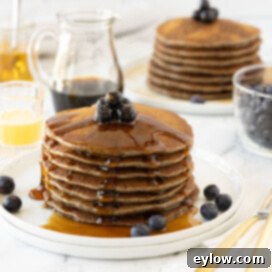
Buckwheat Pancakes
Sally Cameron
Pin Recipe
Equipment
-
Non-stick pan or griddle
-
Pancake turner or thin spatula
Ingredients
- 1 cup buckwheat flour 4.7 ounces
- ¾ cup gluten-free flour blend or white wheat flour 3.7 ounces
- 1 ½ teaspoons baking powder
- ¾ teaspoon baking soda
- ½ teaspoon sea salt
- 2 large eggs
- 2 ½ cups buttermilk
- 3 tablespoons oil see notes below for best oils
- 2 tablespoons honey or monk fruit honey or sugar
- 1 teaspoon vanilla extract
Optional toppings
- Warm maple syrup or sugar-free (monk fruit) maple syrup
- Easy strawberry sauce recipe link below
- Fresh berries of choice
- Warm melted butter
- melted coconut oil
Instructions
-
In a large bowl, combine all dry ingredients: both flours, baking powder, baking soda, and salt. Whisk them thoroughly to ensure they are well mixed and evenly distributed.
-
In a separate medium bowl or a 4-cup liquid measuring cup, whisk the eggs until they are smooth. Then, add the buttermilk, oil, honey (or chosen sweetener), and vanilla extract. Whisk these wet ingredients together until the mixture is uniform and smooth.
-
Pour the combined wet ingredients into the bowl with the dry ingredients. Mix gently with a whisk or spatula until the batter is just combined. A few small lumps are perfectly fine and even preferred; avoid overmixing, as this can lead to tough pancakes.
-
Heat a large non-stick pan or griddle over medium heat. Lightly brush or wipe the surface with a tiny bit of extra oil. Once the pan is hot, use a ¼ cup measure to drop portions of batter into the pan for each pancake. Cook the pancakes on the first side for about 1 ½ minutes, or until small bubbles appear on the surface and the edges look set. Carefully flip the pancakes and cook for another 1 to 1 ½ minutes on the second side until they are beautifully golden brown.
Avoid overcooking the pancakes, as the goal is a lovely golden brown, not a dark brown. If they are browning too quickly, slightly reduce your heat.
As each pancake finishes cooking, you can serve them immediately. Alternatively, remove them to a parchment-lined baking tray and keep them warm in a low oven (around 200°F or 95°C) or a warming drawer until you are ready to serve the entire batch.
-
To serve these delicious buckwheat pancakes, drizzle them generously with warm melted butter or coconut oil. A pour of warm maple syrup (or sugar-free maple syrup) is also a classic and delightful option. Another fantastic choice is a fresh, vibrant fruit sauce, such as an easy strawberry coulis, which adds a burst of freshness and natural sweetness.
Notes
- These pancakes are highly adaptable! You can choose to make them with 100% buckwheat flour for a pronounced nutty flavor, or use the recipe’s suggestion of combining buckwheat flour with a gluten-free flour blend or regular wheat flour for a lighter texture. The choice is yours based on preference and dietary needs.
- To effectively reduce the sugar and carbohydrate content of your pancakes, I highly recommend using a sugar-free honey that is made with monk fruit. This is my personal preferred method for sweetening these pancakes without adding extra sugar.
- For optimal health and flavor, select a high-quality oil. Excellent choices include melted coconut oil (ensure it’s completely melted before adding), MCT oil, or other healthy, neutral oils such as those from Zero Acre Farms. These oils provide a light texture and don’t overpower the buckwheat flavor.
- If you’d like to make the easy strawberry sauce mentioned, you can find the full recipe here: Recipe for the easy strawberry sauce. This versatile sauce can also be made with other fresh berries like raspberries or blueberries for a delightful variation.
